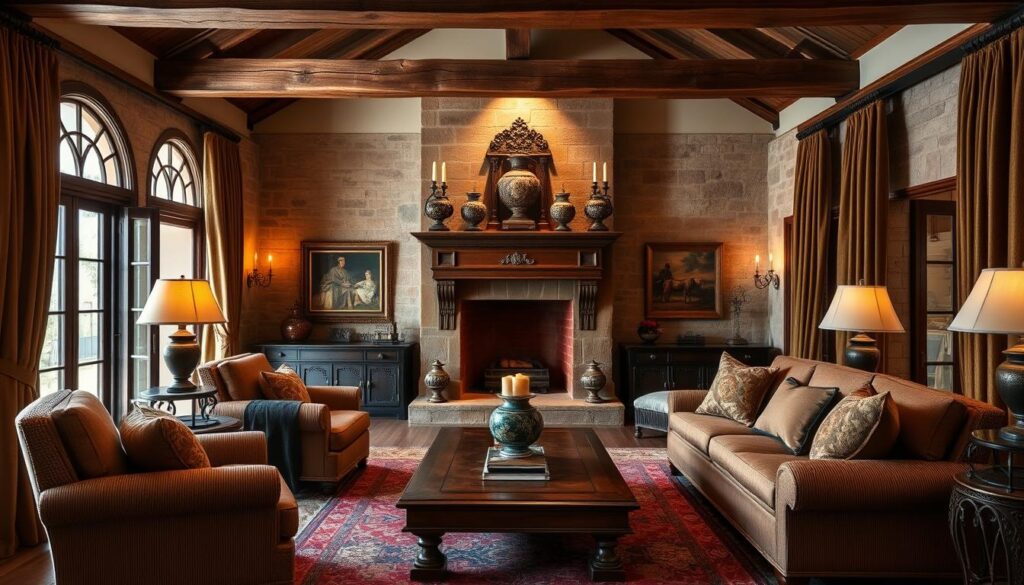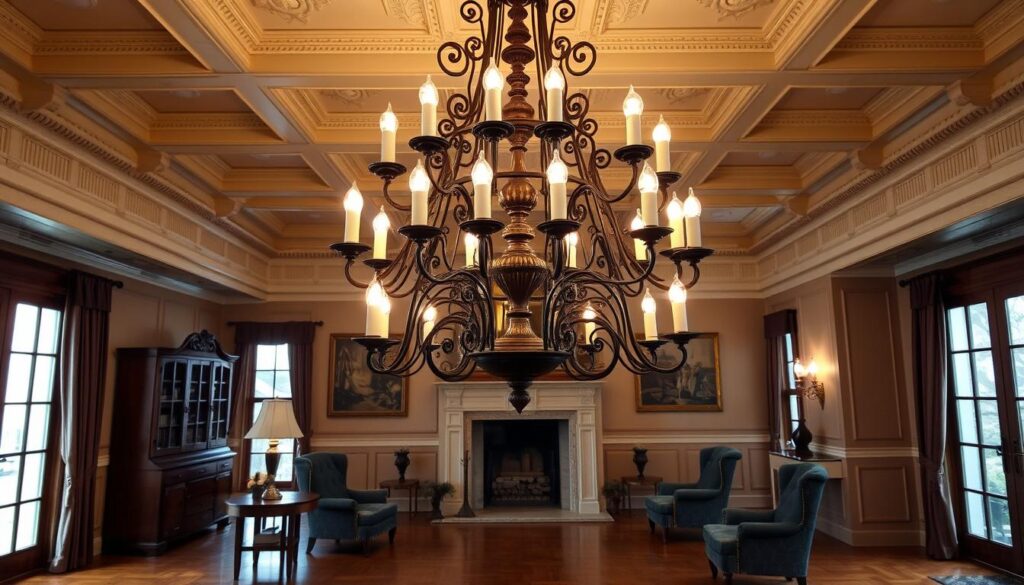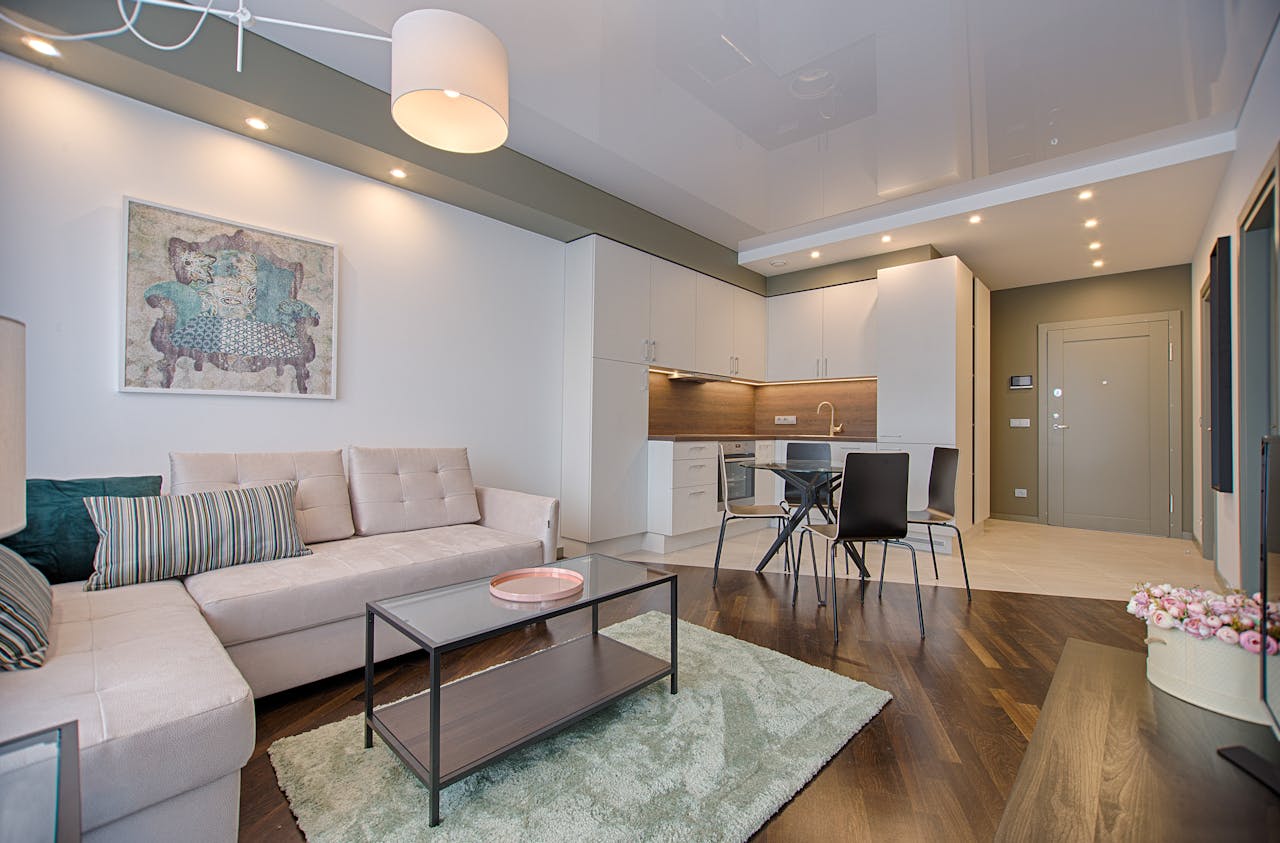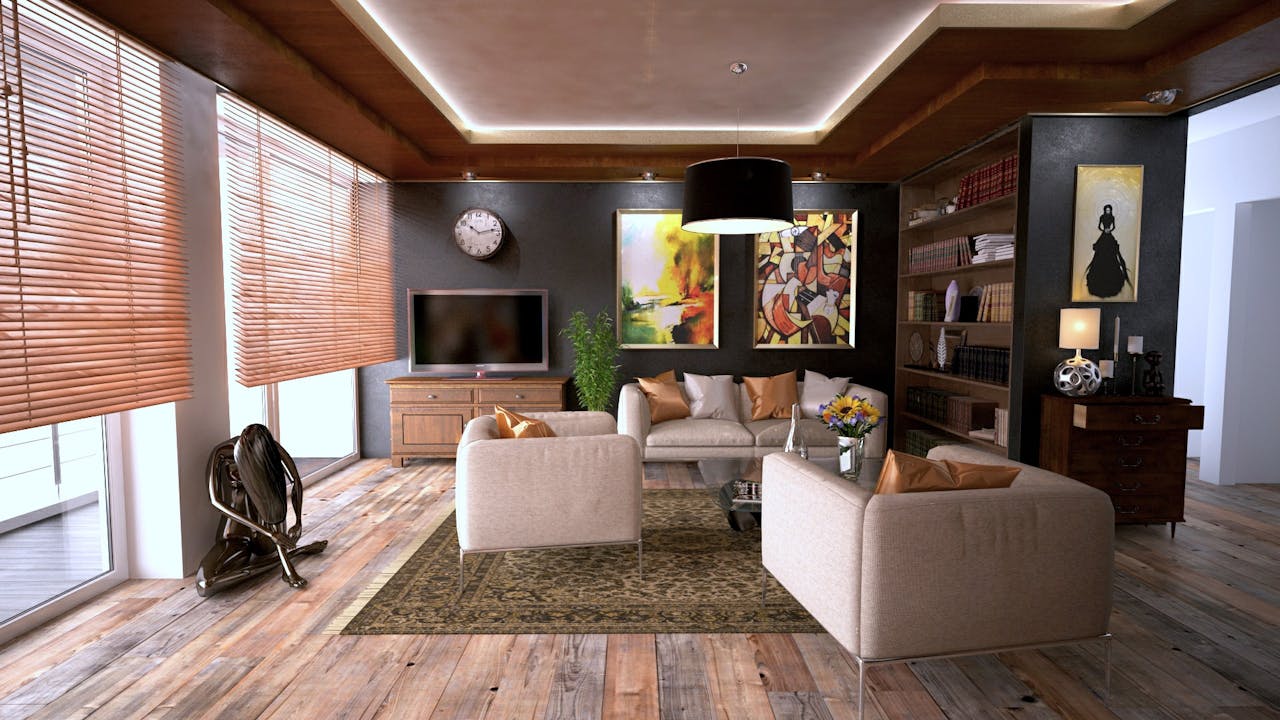The charm of Colonial-style interiors has won hearts for centuries. It offers a mix of simplicity and elegance that lasts.
Colonial design is rooted in tradition and practicality. It adds warmth and authenticity to any room, making it a favorite for a classic look.
We’ll dive into the key elements and decor tips that make this style iconic. You’ll learn how to make your home both beautiful and welcoming.
Key Takeaways
- Understanding the history and characteristics of Colonial design
- Essential elements that define Colonial-style interiors
- Decor tips for creating an authentic Colonial look
- Inspiration for enhancing your home’s simple beauty
- Practical advice for incorporating Colonial style into your space
Understanding Colonial Home Interior Design
Exploring Colonial home interior design takes us back in time. It shows the roots of American design. This style reflects the country’s colonial history and cultural values.
Key Characteristics of Colonial Style
Colonial design focuses on symmetry, classic colors, and wood and natural materials. It’s known for elegant furniture, detailed moldings, and ornate touches. These features highlight its historical roots.
Rich textiles like velvet and linen add warmth to these homes. Antique pieces and classic patterns, such as damask and toile, bring authenticity and tradition.
Historical Influences on Colonial Design
The development of Colonial design was shaped by the American colonies’ culture and history. European settlers brought their design traditions. These were adapted to the new environment’s materials and needs.
Over time, Colonial design was influenced by various periods and styles, like Georgian and Federal. This mix of European and American influences created a unique style. It’s timeless and elegant, as seen in today’s “Colonial Chic” trend.
Popular Colonial Home Styles in the U.S.
The United States has many Colonial home styles, each with its own look and history. Different areas developed their own styles, shaped by culture, society, and geography.
Colonial homes show early American history and the influences on the country’s buildings. From the Georgian Colonials with their classical details to the Federal Colonials with their delicate ornamentation, each style gives a glimpse into the past.
Georgian Colonial
Georgian Colonial homes have symmetrical facades and classical details. This style, from the 18th century, was influenced by England’s Georgian era. They have multi-paned windows, decorative cornices, and a central front door with a pediment.
Key Features of Georgian Colonial Homes:
- Symmetrical facade
- Classical details and ornamentation
- Multi-paned windows
- Decorative cornices
- Central front door with pediment
Federal Colonial
Federal Colonial homes evolved from the Georgian style. They have more refined ornamentation. Known for their elegant proportions and classical motifs, Federal Colonials show a more sophisticated design.
“The Federal style is distinguished by its elegance and refinement, marking a significant shift towards a more sophisticated architectural aesthetic.” This style shows the growing wealth and cultural aspirations of the young American nation.
Dutch Colonial
Dutch Colonial homes are known for their gambrel roofs. They are common in the Northeast, where Dutch influence was strong. They have a broad, flared eaves and a gambrel roof with flared sides, giving them a cozy look.
When decorating with Colonial styles, use classic colors and traditional furniture. Dutch Colonials, with their warm look, are great for those who love early American style decor.
Essential Elements of Colonial Interior Design
To get the authentic Colonial look, knowing the key elements is crucial. Colonial design mixes old and new, making spaces warm and welcoming.
Symmetry in Layout
Symmetry in layout is a big part of Colonial design. It means arranging furniture and decor evenly around a central point, like a fireplace. This symmetry brings order and beauty to the space.
Classic Color Palettes
Colonial interiors stick to classic color palettes. They use light neutrals and whites. These colors reflect the past and cool down warm spaces. Soft colors add to the elegance of Colonial design.
The choice of light neutrals and whites is key. It makes Colonial interiors timeless and appealing.
Use of Wood and Natural Materials
Wood and natural materials are vital in Colonial design. Wooden pieces, floors, and walls add warmth and texture. These materials connect us to history.
Using these elements in your home brings a classic Colonial vibe. Focus on symmetry, classic colors, and natural materials for a space that’s both elegant and cozy.
Furniture Choices for Colonial Interiors
Colonial interiors are known for their traditional furniture. This furniture is both functional and charming. When picking furniture for a Colonial home, look for pieces that show the era’s craftsmanship and style.
Signature Furniture Styles
Colonial homes have unique furniture styles. Each style has its own historical importance. Here are some notable ones:
- Queen Anne: This style has cabriole legs and detailed carvings. It brings elegance to Colonial interiors.
- Chippendale: Known for its elegant design and detailed work, Chippendale furniture is key to Colonial decor.
- Early American: Early American furniture is rustic and casual. It adds warmth and authenticity to a room.
Incorporating Antiques
Adding antiques to your Colonial interior design adds history and charm. Antiques are not just furniture; they spark conversations and add depth. When choosing antiques, keep these tips in mind:
- Choose pieces that show the Colonial era’s craftsmanship and materials.
- Make sure the antiques are in good shape or can be fixed.
- Balance antique pieces with other room elements to avoid clutter.
“The right antique can become the centerpiece of a room, tying together various design elements and adding a layer of history.”
Comfort vs. Aesthetic
Keeping a Colonial interior looking good is important. But comfort is just as crucial. Modern Colonial homes mix old styles with new comforts. Here’s how to do it:
- Pick furniture that looks good and feels comfortable.
- Update antique furniture with modern fabrics for better comfort.
- Add modern comforts like soft pillows and rugs to your Colonial decor.
By choosing furniture that respects the Colonial era but also meets today’s needs, you can make a space that’s both stunning and cozy.
Colonial Floor Plans and Space Layout
The layout of a Colonial home is key to its charm and function. These homes are great for hosting guests or relaxing, with lots of space and bedrooms. They often have multiple stories.
Traditional Room Configurations
Traditional Colonial homes have a simple, symmetrical floor plan. They have a central hallway with rooms on both sides. This layout is both beautiful and practical, making it easy to move around.
Key elements of traditional room configurations include:
- A central entrance hall that sets the tone for the interior
- Symmetrical room placement on either side of the hall
- A formal living room and dining room for entertaining
- A practical kitchen layout that often includes a separate dining area or a breakfast nook
Open vs. Closed Spaces
Choosing between open and closed spaces is a big decision in Colonial home design. Traditional homes have separate rooms for different uses. But, modern homes might have open-plan living for a more contemporary look.
When deciding between open and closed spaces, consider the following factors:
- The need for privacy and separation between areas
- The desire for a more modern, airy feel
- The importance of maintaining historical integrity
Understanding Colonial floor plans can help you create a space that is both functional and elegant. It meets your needs while staying true to history.
Color Schemes for Colonial Interiors
The color scheme is key to a true Colonial interior design. Colonial homes are known for their classic look. The right colors bring out this timeless appeal.
Soft, muted neutral tones are best for Colonial homes. They reflect the historical design and make the space warm and welcoming.
Popular Colonial Color Palettes
Colonial interiors often use subtle, earthy tones. Some favorite color schemes include:
- Soft whites and creams
- Muted greens and blues
- Warm beiges and taupes
- Rich wood tones
| Color | Description | Common Use |
|---|---|---|
| Soft White | A clean, neutral white | Walls, trim |
| Muted Green | A subtle, earthy green | Furniture, accents |
| Warm Beige | A comforting, neutral beige | Walls, furniture |
Using Bold Accents
Colonial interiors are known for their subtle elegance. But, bold accents can add interest and depth. Use bold colors in:
- Rugs and upholstery
- Artwork and accessories
- Statement furniture pieces
By mixing soft tones with bold accents, you can make a Colonial interior both authentic and lively.

Remember, balance and restraint are crucial in Colonial interiors. Choose colors that reflect the Colonial era and use bold accents wisely. This way, you can create a space that is both stunning and respectful of history.
Textiles and Patterns in Colonial Design
Choosing the right textiles and patterns is key for a true Colonial interior design. Textiles were not just for function but also for beauty. The era’s fabrics, patterns, and colors made the Colonial style unique and rich.
Choosing Fabrics and Curtains
The Colonial era loved natural fibers like cotton, wool, and linen. These were durable and showed the era’s simplicity and practicality. Using these fibers for curtains or upholstery keeps your space true to Colonial style.
For curtains, velvet or thick cotton drapes were common. They were often simple yet elegant. These drapes controlled light and added luxury to the room.
Historical Patterns that Work
Colonial design patterns were inspired by Europe, with floral motifs, stripes, and geometric designs. These patterns were on fabrics, wallpaper, and furniture, creating a unified look.
To add historical patterns to your space, use damask, toile, or paisley on fabrics or wallpaper. These patterns bring depth and character, making your space feel more authentic.
| Fiber | Characteristics | Uses |
|---|---|---|
| Cotton | Breathable, durable | Upholstery, curtains |
| Wool | Warm, resilient | Upholstery, rugs |
| Linen | Lightweight, natural texture | Curtains, tablecloths |
Lighting Solutions for Colonial Homes
Choosing the right lighting is key to capturing the colonial home’s essence. The right lighting can make your space feel authentic and welcoming.
Traditional Lighting Fixtures
Traditional lighting fixtures like cast-iron lamps, chandeliers, and candle holders are typical of colonial decor. These not only light up the space but also decorate it, adding to the colonial look.
Cast-iron lamps were popular back then for their durability and classic style. Chandeliers, often made from brass or crystal, bring elegance to any room. Candle holders, simple or ornate, add warmth and coziness.

Modern Adaptations
While traditional lighting is crucial, modern adaptations can also be used to improve functionality and efficiency. Modern lighting can look like traditional fixtures but have today’s technology.
For instance, LED candles or electric lanterns can look like old candles but are safer and use less energy. Also, dimmer switches can change the lighting for different events, from formal dinners to casual get-togethers.
Incorporating Modern Elements into Colonial Design
Colonial Chic is a design trend that blends classic colonial elements with modern flair. It’s great for those who love their traditional colonial home but want it to look fresh and functional. This style keeps the historical charm while adding a modern twist.
Blending Old and New
To mix old and new well, you need to know what makes colonial design special. Symmetry, classic colors, and natural materials are key. Adding modern pieces that match these elements can make your space welcoming and unique.
For example, adding contemporary furniture with simple designs can stand out against traditional pieces. Also, updating your lighting with modern styles can change your home’s feel.
Contemporary Accessories
Accessories are crucial in mixing modern touches with colonial design. Artwork, rugs, and decorative items can bring a modern vibe to your space. Choose accessories that match the colors and textures of traditional colonial homes.
- Modern artwork can add color and personality to your walls.
- Contemporary rugs with traditional patterns can blend styles beautifully.
- Decorative items that reflect colonial shapes and materials are a good choice.
By carefully adding modern touches to your colonial home, you can make it both historically rich and stylishly modern.
Tips for Achieving Authentic Colonial Decor
To get the look of Colonial decor right, we need to understand the era’s history and design. We must think about what made the Colonial period special. This will help us create a space that truly feels like early America.
American colonists decorated their homes with items from travels or family. This made their homes personal and showed their history. When decorating in a Colonial style, we should look for items with historical significance.
Sourcing Authentic Pieces
Finding furniture and decor that’s true to the Colonial era is key. Look in antique shops, estate sales, and with dealers who know colonial style decorating tips. Choose items made with solid wood and natural fabrics, common in Colonial times.
Using antiques or high-quality reproductions adds to the authenticity. It’s also important to know the history of each piece. This helps us understand its original use in Colonial times.
The Importance of Details
The small details are crucial for a Colonial-style interior. Think about hardware, lighting, and textiles. Brass or iron hardware, for example, was common back then.
Choosing textiles like toile or damask adds to the authenticity. Also, use colors that were popular in early America. These should be subdued and earthy.
By focusing on these details, we can create a space that honors history. Authentic Colonial decor is not just about looks. It’s about telling a story that connects us to the past.
Maintaining Colonial Aesthetics in Renovations
Renovating a Colonial-style home needs careful thought. We aim to keep its classic charm while adding modern comforts. It’s about mixing old elegance with new needs.
Preserving Historical Integrity
Keeping the vintage look means saving the home’s original parts. This includes moldings, woodwork, and floors. We try to keep these as is.
Balancing Modern Needs with Classic Style
We can add modern touches without losing the classic feel. This means using new lighting, updated kitchens and bathrooms, and smart storage. These updates should match the home’s old style.
By finding a balance, we make a space that respects history and welcomes today’s comforts. This way, we honor the past and enjoy the present.



